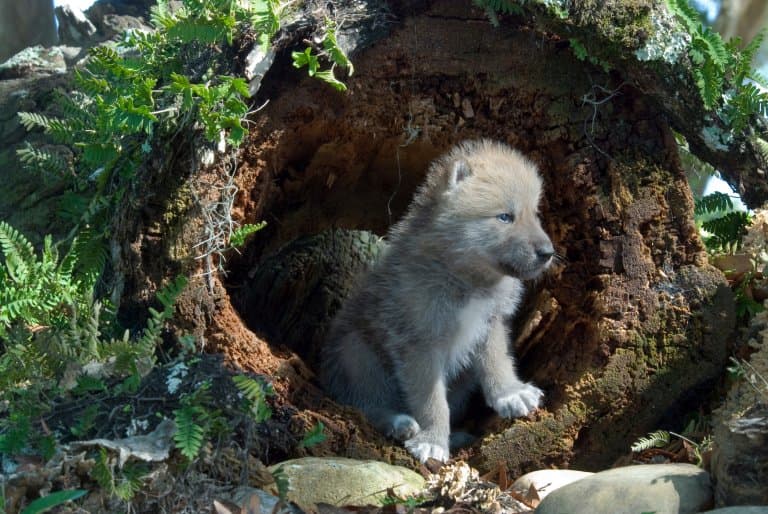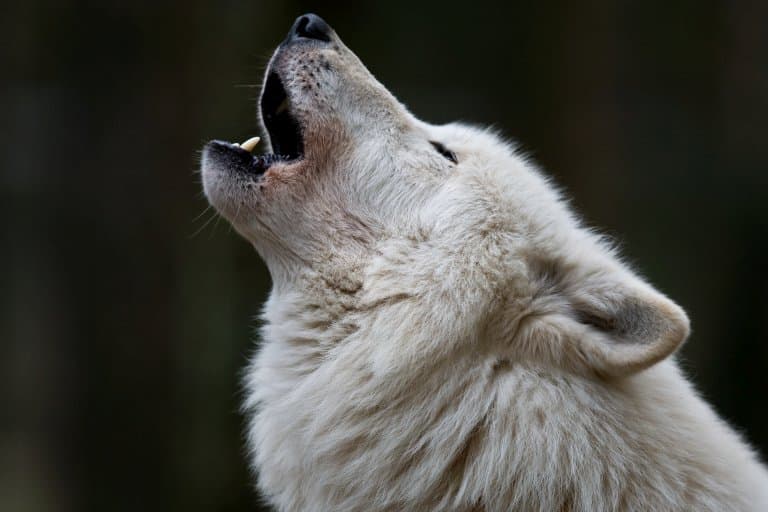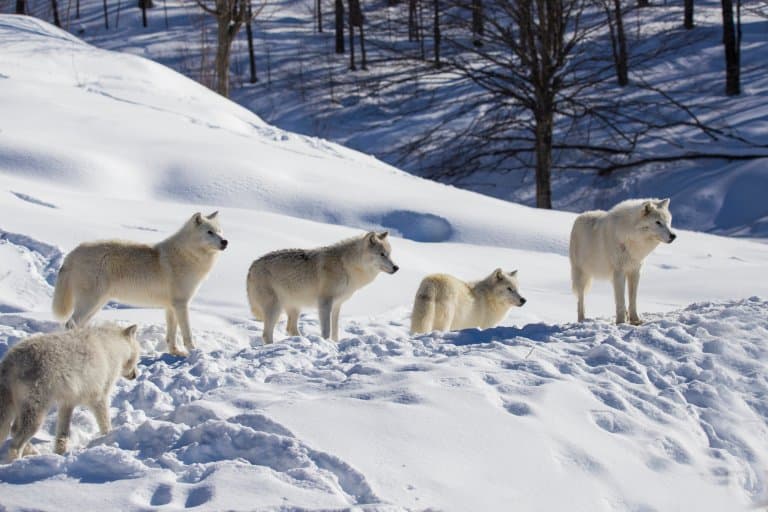Arctic Wolf Profile
The Arctic wolf is a sub-species of the gray wolf. They reside on the Northern edge of the North American continent, up into the North Pole, and along some Northern and Eastern shorelines of Greenland. They are also known as the white wolf, or polar wolf.
Arctic wolves live in packs ranging from 4-7 members in size, depending on how much food is around. The social organization within these packs is complex, with different members having different roles.
Arctic wolves have vast territories and they will roam large distances to find and hunt food. They have good stamina, and can run fast when chasing down their prey.

Arctic Wolf Facts Overview
| Habitat: | Arctic Tundra |
| Location: | Northern edge of the North American continent up into the Arctic and on some Greenland coastlines |
| Lifespan: | 7-17 years |
| Size: | Height 63-79cm, Length 0.9-1.8m (including the tail) |
| Weight: | 32-70kg |
| Color: | White, cream, black, gray |
| Diet: | Musk-oxen, caribou, moose, Arctic hares, lemmings, ptarmigan, nesting birds |
| Predators: | Humans (although seldom) |
| Top Speed: | 75 kph (46 mph) |
| No. of Species: |
Industrial expansion in the Arctic is one of the main threats |
| Conservation Status: |
Least Concern |
Artic wolves have a number of special adaptations that limit their exposure to freezing air temperatures and help maintain body heat.
They hunt in packs, with each member having a specific role. Within the pack there is usually an alpha male and female and they are the individuals that give signals to the others on how to behave.
On the whole Artic wolves will target large prey species such as musk-oxen that are too large to be tackled alone. This is where group hunting comes into play. They use their powerful jaws and teeth to attack the animal and help bring it down together. They will often track and attack animals that live in groups, such as caribou.
The alpha male and female are usually the only ones who produce offspring. The structure of a wolf pack is complex, with members of the group forming strong bonds with other individuals. This is important for the stability of the group.
Arctic wolves communicate with each other in a variety of ways. They may bare their teeth and growl to show aggression or fear (in a similar way to domestic dogs). If they want to show a more submissive stance they may put their ears backwards or lie on their backs (again, much like a domestic dog).
They also like to interact vocally with barks, whines, snarls and howls. Howls can often signal a hunt is about to start or that they want to play.
Litters of pups are born in dens, similar to other canine species. They typically give birth to 2-3 young. Pups will feed from their mother (usually the alpha female) and some lower ranking females.
After about 6 weeks, food will be regurgitated from the adults and given to the pups also. When they reach around 6 months old they are considered adults and will join the pack in hunting.
Interesting Arctic Wolf Facts
1. Arctic wolves can cope with the extremes
Temperatures in the Arctic can get as cold as -300c (and will feel colder because of wind chill), but because of their adaptations, Arctic wolves can survive in this extreme situation.
While smaller than the gray wolf, their bodies are stockier with shorter legs. They are well adapted to the extreme cold; having a shorter muzzle and smaller ears than their southern counterpart.
They have padded paws to help them grip the ice and snow that they run on and two layers of extremely thick fur, with one layer being waterproof to help keep water away from their skin.
Their fur colouration also helps them blend into their environment, which is very useful when trying to sneak up on their prey when hunting.
In the Arctic, the hours of daylight can be limited at certain times of year and this is something that they are adapted to also. 1

2. The Arctic wolf and the gray wolf are still considered the same species
Because the Arctic wolf and the gray wolf can still interbreed, they are considered the same species.
However in the wild, as they occupy different regions and are adapted to these specific regions it is unlikely that this actually takes place.
3. Arctic wolves are an apex predator
As there is nothing that predates upon them in their environment, these wolves are known as the apex (top) predator.
They help keep their environment in check, by keeping herbivores such as the musk-oxen or artic hare numbers low.
4. They travel insane distances
Because their prey aren’t always easy to find (linked to limited vegetation in the wolf’s habitat) they have been known to roam in areas of up to 2,600 km squared to find food.

5. There is always one large male
The alpha male, or main male in the pack is always the largest member. He will carry on growing when all the other males have stopped. Male wolves in general are larger than the females (known as sexual dimorphism). 2
6. Arctic Wolves like to talk with their urine
Wolves scent mark to show other wolves that they are there and where their territories lie. They use it to deter other wolves from coming too close.
7. Arctic wolf packs have a puppy sitter
When the majority of the pack goes off to hunt, one adult has to stay behind to look after the pups that are left and are too young to go and hunt.

8. Wolf dens aren’t always made from soil
Because of the landscape in which these wolves live, covered in ice and snow, it can be hard for adults to physically dig a den for their young. They will often choose rocky ridges or caves to give birth under/in.
9. Their eye color changes with age
When Arctic wolf pups are born they usually have fairly dark fur and blue eyes. As they get older their fur lightens and their eyes turn to a more amber colour.
10. Howling is important
Different wolf packs can show where they are using howling. Listening to other groups doing this gives an indication of where they are and where there territories lie.
Wolves can also get an idea of the size of a wolf pack from their howling and this in turn can give them an idea of whether they should avoid them or not.

11. Arctic wolves aren’t afraid of humans
It is thought that because these wolves very rarely come into contact with humans and live in relative isolation, when they do come into contact with them they do not have a big fear of them.
12. Climate change is a big threat to the Arctic wolf
More extreme weather conditions have reduced the amount of vegetative food available for some of the animals that the Arctic wolf predates on. This therefore impacts the number of Arctic wolf that can feed in a given area and this can impact the size of area in which they need to roam. 3
13. Industrialisation is another threat
Arctic wolves don’t come into contact with humans a lot and aren’t generally hunted. However as the Arctic becomes more industrial, with things such as mines, oil pipelines and roads being built, this impacts the areas in which the Arctic wolf needs to roam, most importantly to find food.

14. They are hard to study
Because Arctic wolves live in such a harsh and extreme environment, it is more difficult for people to study their behaviours and movements.
Arctic Wolf Fact-File Summary
Scientific Classification
| Kingdom: | Animalia |
| Phylum: | Chordata |
| Class: | Mammalia |
| Order: | Carnivora |
| Family: | Canidae |
| Genus: | Canis |
| Species Name: |
Canis Lupus |
| Species Name: |
Canis Lupus Arctos |
Fact Sources & References
- Neil Shea (2019), “Inside the harsh lives of wolves living at the top of the world”, National Geographic.
- “Arctic Wolf”, WWF.
- “Care For Us Arctic Wolf (Canis lupus arctos)”, Wild Warefare.
